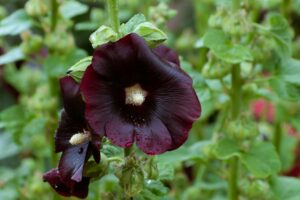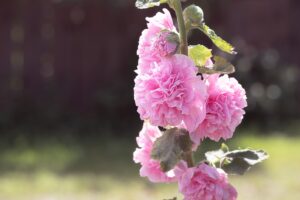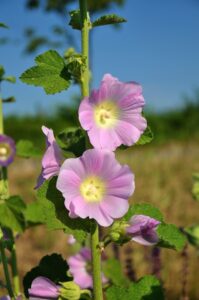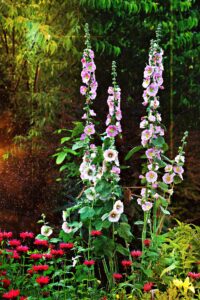The Hollyhock Flowers is a striking and tall flowering plant known for its towering spires of large, colorful blooms. Belonging to the Malvaceae family, hollyhocks are popular for their old-fashioned charm and their ability to add vertical interest to gardens.
Hollyhocks are characterized by their tall, erect stems that can reach impressive heights, often between 5 to 8 feet (1.5 to 2.4 meters) or more. Hollyhock leaves are generally palmately lobed, resembling the shape of a hand with outstretched fingers. They are rough to the touch and add to the plant’s overall texture.

Hollyhock flowers are the highlight of the plant, forming along the tall spikes or racemes. The blooms come in a wide array of colors, including shades of pink, red, yellow, white, and purple. Some varieties exhibit bicolor or multicolor flowers. Flowers may be single or double, with a central cone or contrasting centers in some varieties. Each flower consists of five petals, creating a saucer or cup-like appearance.
Hollyhocks typically bloom in late spring to early summer, creating a spectacular display of color in the garden. The flowering period can extend into midsummer, providing a long-lasting floral show.
Different species and varieties of hollyhocks exist, each with its unique characteristics. Common hollyhock species include Alcea rosea, Alcea rugosa, and Alcea ficifolia.
Hollyhocks are often classified as biennials, meaning they complete their life cycle in two years. In the first year, they produce foliage, and in the second year, they flower. However, some varieties may behave as short-lived perennials.
Cultivars of Hollyhock Flowers
Hollyhocks come in various cultivars, each with its unique characteristics, colors, and growth habits. Here are some popular cultivars of hollyhock flowers:
Alcea rosea ‘Nigra’ (Black Hollyhock): Features striking, dark maroon to black flowers. The single-flowered variety adds a dramatic and unique element to the garden.

Alcea rosea ‘Chater’s Double’ (Double Hollyhock Mix): Known for its large, fully double flowers with a ruffled appearance. Available in a mix of colors, including pink, red, white, and yellow. Provides a lush and vibrant display in cottage gardens.

Alcea rosea ‘Halo Mix’ (Halo Hollyhock Mix): This cultivar features single or semi-double flowers with contrasting “halos” or eyes around the central cone. Available in various colors, adding visual interest to the blooms.
Alcea rosea ‘Peaches ‘n Dreams’: A lovely cultivar with soft peach-colored flowers. Semi-double blooms with a hint of yellow at the center. Adds a gentle and warm touch to the garden.

Alcea rosea ‘Queeny Purple’ (Queen Hollyhock): Known for its vibrant and rich purple-colored flowers. Compact growth habit compared to some other hollyhock varieties. Ideal for smaller gardens or containers.
Alcea rosea ‘Majorette Mix’: Dwarf hollyhock variety with a more compact habit. Features double blooms in a mix of colors. Suitable for smaller spaces and front-of-the-border plantings.

Alcea ficifolia ‘Happy Lights’ (Antwerp Hollyhock): A perennial hollyhock variety with a more extended lifespan. Offers a mix of cheerful colors, including yellow, pink, and red. Resistant to rust, a common hollyhock disease.
Alcea rugosa ‘Creme de Cassis’: Known for its elegant, burgundy-colored flowers with creamy edges. Features a more subtle and sophisticated color palette. Attracts butterflies and pollinators to the garden.
Alcea rosea ‘Spring Celebrities’ Series: A series of dwarf hollyhocks with a bushy and compact growth habit. Available in various colors, offering a range of options for smaller gardens or containers. Early blooming compared to some other varieties.
Alcea rosea ‘Pinafore Pink’: Single-flowered hollyhock with delicate, soft pink blooms. Tall spikes add elegance to the garden, especially when planted in groups. Attracts butterflies and hummingbirds.

When selecting a hollyhock cultivar, consider factors such as height, flower form, color, and growth habit to complement your garden design. Hollyhocks are versatile and can be used in various settings, from cottage gardens to formal borders, providing vertical interest and a splash of vibrant color.
Sunlight Requirement of Hollyhock Flowers
Hollyhocks thrive in locations that receive full sunlight, which is defined as at least 6 to 8 hours of direct sunlight each day. Plant hollyhocks in a spot in your garden where they will receive maximum sunlight exposure throughout the day. While hollyhocks generally appreciate full sun, in extremely hot climates, they may benefit from some protection during the hottest part of the day, especially if the sunlight is intense.
If you are growing hollyhocks in containers, ensure that the containers receive sufficient sunlight. Place the containers in locations with full sun exposure for the best results.
Temperature and Humidity Requirement of Hollyhock Flower
Hollyhock flowers are generally adaptable and can tolerate a range of temperatures and humidity levels. Hollyhocks are hardy plants and can tolerate a range of temperatures. They are suitable for USDA hardiness zones 3 to 9. They thrive in temperatures between 60°F to 75°F (15°C to 24°C) during the growing season.

Hollyhocks are generally cold-tolerant and can withstand frost. They often benefit from a period of winter chill to encourage flowering in the following growing season. While hollyhocks can tolerate heat, in extremely hot climates, they may benefit from some protection during the hottest part of the day, especially if temperatures consistently exceed their preferred range. Hollyhocks are adaptable to different humidity levels and can grow in both humid and drier conditions.
Soil Requirement
Hollyhocks prefer well-draining soil to prevent waterlogging, which can lead to root rot and other issues. Good drainage is especially crucial during the winter months. They thrive in fertile, loamy soil. Loamy soil is a balanced mix of sand, silt, and clay, providing good drainage while retaining essential nutrients.
Hollyhocks prefer a slightly acidic to neutral soil pH ranging from 6.0 to 7.0. Incorporating organic matter into the soil, such as well-rotted compost, can enhance fertility and improve soil structure. This is particularly important for hollyhocks, as they benefit from nutrient-rich soil.
Prepare the planting area by loosening the soil to a depth of at least 12 inches (30 cm) before planting hollyhock seeds or seedlings. This promotes better root development and establishment.

Propagation of Hollyhock flowers
Hollyhock flowers (Alcea) can be easily propagated through seeds, and growing them from seed is a common and cost-effective way to introduce these beautiful plants to your garden.
Sow hollyhock seeds either directly in the garden or in containers indoors.
If starting indoors, sow the seeds 8 to 10 weeks before the last expected frost date in your area.
Use seed-starting trays or pots with well-draining seed-starting mix.
Sow the seeds on the surface of the soil and lightly press them down. Do not cover them with soil, as hollyhock seeds require light for germination.
Mist the surface with water to settle the seeds.
Place the seed trays or pots in a warm location with indirect sunlight. Hollyhock seeds typically germinate in 10 to 20 days.
Keep the soil consistently moist but not waterlogged during the germination period.
Once the seedlings have developed several true leaves and are large enough to handle, transplant them into individual pots or directly into the garden.
Space the seedlings at least 18 to 24 inches apart to allow for proper growth and air circulation.
Outdoor Sowing:
If sowing directly in the garden, wait until the soil has warmed in the spring.
Broadcast the seeds on the soil surface and gently press them down. Again, do not cover the seeds with soil.
Keep the area consistently moist until germination occurs.
Choose a sunny location for hollyhocks with well-draining soil.
Water regularly to keep the soil consistently moist, especially during dry periods.
If you’ve sown seeds densely, thin out the seedlings once they are large enough to handle. This ensures that each plant has enough space to grow and develop.

Irrigation
Hollyhock flowers have moderate water requirements, and providing consistent and appropriate irrigation is crucial for their growth and overall health. Hollyhocks benefit from regular watering, especially during dry periods. While they are somewhat drought-tolerant once established, consistent moisture promotes healthy growth and flowering. Keep the soil consistently moist but not waterlogged.
Water hollyhocks when the top inch (2.5 cm) of soil feels dry to the touch. When watering, aim for deep saturation of the soil around the root zone. This encourages the development of a robust root system.
While hollyhocks can tolerate some drought conditions, prolonged periods of drought without water may lead to stress and reduced flowering. Providing supplemental water during dry spells is beneficial.
Fertilizer requirement of Hollyhock Flowers
Before planting hollyhock seeds or seedlings, amend the soil with well-rotted compost or aged manure. This initial soil enrichment provides a foundation of nutrients for the growing plants.
Use a balanced, all-purpose fertilizer with equal proportions of nitrogen (N), phosphorus (P), and potassium (K). For example, a 10-10-10 or 14-14-14 fertilizer is suitable for hollyhocks. Apply the first round of fertilizer in early spring when new growth begins. A second application can be made in early summer to support continued flowering. For perennial hollyhock varieties, fertilize in early spring and, if needed, again in midsummer.
If preferred, use slow-release fertilizers that provide nutrients gradually over an extended period. This can reduce the frequency of applications. While nitrogen is essential for foliage growth, excessive amounts can lead to lush foliage at the expense of flowering. Avoid overusing high-nitrogen fertilizers.

Problems While Growing Hollyhock Flowers
While hollyhocks are generally hardy and resilient plants, they can face some common issues that may affect their growth and appearance. Here are potential problems you might encounter while growing hollyhock flowers and some tips on how to address them:
Rust Disease: Orange or rust-colored spots on the undersides of leaves, which may lead to yellowing and premature leaf drop. Provide good air circulation, avoid overhead watering, and consider using fungicides labeled for rust prevention. Remove and destroy infected leaves.
Powdery Mildew: A white powdery substance on the leaves, often causing distortion and yellowing. Improve air circulation, avoid overhead watering, and apply fungicides if needed. Prune affected leaves and clean up debris.
Aphids: Clusters of small, soft-bodied insects on the undersides of leaves, causing yellowing and distortion. Use insecticidal soap or neem oil, encourage natural predators like ladybugs, and wash aphids off with a strong stream of water.
Japanese Beetles: Skeletonized leaves and damaged flowers due to feeding by adult beetles. Handpick beetles, use neem oil or insecticidal soap and consider applying beneficial nematodes to control larvae in the soil.
Bacterial Leaf Spot: Dark spots with yellow halos on leaves, leading to leaf yellowing and drop. Remove and destroy affected leaves, avoid overhead watering, and apply copper-based fungicides.
Poor Flowering or Stunted Growth: Insufficient sunlight, overcrowding, poor soil fertility, or disease. Ensure proper sunlight, space plants adequately, provide well-draining soil rich in organic matter, and address any underlying disease issues.
Regular monitoring, prompt action when problems arise, and providing optimal growing conditions can help keep your hollyhocks healthy and vigorous. Always choose appropriate preventive measures and organic controls when possible to maintain a thriving garden.
Ornamental Uses of Hollyhock Flowers
Hollyhock flowers are valued in gardens for their tall, stately spikes of colorful blooms, adding a touch of old-fashioned charm and vertical interest. Here are various uses of hollyhock flowers in landscaping and garden design:
Back-of-the-Border Planting: Hollyhocks are often used as back-of-the-border plants due to their tall growth habit. Placing them at the rear of flower beds or along fences allows their impressive spikes to stand out.

Cottage Gardens: Hollyhocks are classic additions to cottage gardens, contributing a nostalgic and romantic feel. Their vibrant flowers complement the informal and diverse plantings common in cottage-style landscapes.
Cut Flower Gardens: Hollyhocks make excellent cut flowers, providing vertical accents in floral arrangements. The long spikes and range of colors add drama to bouquets and vases.
Pollinator Gardens: The nectar-rich flowers of hollyhocks attract pollinators such as bees, butterflies, and hummingbirds. Including hollyhocks in pollinator-friendly gardens helps support biodiversity.

Formal Gardens: Despite their informal appearance, hollyhocks can also be incorporated into formal garden designs. Placing them strategically among other structured plants creates a dynamic contrast.
Island Beds and Mixed Borders: Hollyhocks work well in island beds and mixed borders, providing vertical elements and punctuating the landscape with splashes of color.
Historical Gardens: Given their long history and traditional associations, hollyhocks are suitable for historical or heritage gardens. They evoke a sense of nostalgia and are reminiscent of old-fashioned garden designs.
Focal Points: Use hollyhocks as focal points in the garden by placing them at the end of pathways or in key viewing areas. Their height and vibrant colors draw attention.
Against Walls or Structures: Planting hollyhocks against walls, fences, or structures allows their tall spikes to lean or climb, creating a vertical display and softening the look of hard surfaces.

Container Gardens: Dwarf or compact hollyhock varieties can be grown in containers, adding a vertical dimension to patios, balconies, or small gardens.
Cut-and-Come-Again Blooms: Regular deadheading encourages continuous blooming, making hollyhocks suitable for providing ongoing color throughout the growing season.
Rain Gardens: In areas with occasional heavy rainfall, hollyhocks can be included in rain gardens. Their deep roots help absorb excess water and prevent soil erosion.

Edging Plantings: Shorter varieties of hollyhocks can be used as edging plants along pathways or in front of taller perennials, creating a layered and visually appealing effect.

Hollyhocks, with their vibrant and showy flowers, offer a versatile and attractive addition to various garden styles and settings. Their adaptability to different garden designs makes them a favorite among gardeners seeking a touch of elegance and nostalgia.


